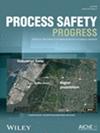柴油-水乳化池火沸腾燃烧行为及热反馈
IF 1
4区 工程技术
Q4 ENGINEERING, CHEMICAL
引用次数: 1
摘要
摘要在海底石油开采和原油运输过程中,海上石油泄漏事故时有发生。溢油在海上风化过程中,有可能与水混合形成油水乳化。就地燃烧是一种低污染、高效的消除溢油的方法。同时,乳化柴油作为一种替代燃料,具有节能减排的优点。采用3个圆形燃料罐(10、15、20 cm)和5种水的质量比(0%、5%、10%、15%、20%)对柴油-水乳化池火的燃烧行为进行了实验研究。从燃烧现象、质量燃烧速率和火焰长度等方面对乳化柴油的不稳定燃烧过程进行了评价。揭示了池直径、水含量比和初始燃料厚度对燃烧速度和火焰长度的影响。根据燃料库物理边界、火焰和壁面温度的耦合因素,探讨了控制燃烧行为的初级换热模式。这项工作对于了解海上溢油的燃烧行为,优化溢油污染物的清除方案具有重要意义。本文章由计算机程序翻译,如有差异,请以英文原文为准。
Boiling combustion behaviors and heat feedback of pool fire of diesel fuel–water emulsification
Abstract In the process of submarine oil exploitation and crude oil shipping, the offshore oil leakage accidents occur frequently. In the process of oil spill weathering on the sea, the oil is potentially mixed with water to form oil–water emulsification. The in situ burning is a low‐pollution and high‐efficiency method to eliminate the spilled oil. Meanwhile, as an alternative fuel, the emulsified diesel fuel has the advantage of energy saving and emission reduction. The combustion behaviors of pool fire of diesel fuel–water emulsifications are experimentally studied using three circular fuel reservoirs (10, 15, 20 cm) and five mass proportions of water (0%, 5%, 10%, 15%, 20%). The unsteady combustion process of emulsified diesel fuel is appreciated based on combustion phenomenon, mass burning rate, and flame length. The effects of pool diameter, ratio of water content, and initial fuel thickness on burning rate and flame length are revealed. The primary heat transfer mode in controlling the combustion behavior is explored according to the coupling factors of physical boundary of fuel reservoir, flame, and wall temperatures. This work is of great significance for understanding the combustion behavior of oil spill on the sea and optimizing the removal scheme of oil spill pollutants.
求助全文
通过发布文献求助,成功后即可免费获取论文全文。
去求助
来源期刊

Process Safety Progress
工程技术-工程:化工
CiteScore
2.20
自引率
10.00%
发文量
99
审稿时长
6-12 weeks
期刊介绍:
Process Safety Progress covers process safety for engineering professionals. It addresses such topics as incident investigations/case histories, hazardous chemicals management, hazardous leaks prevention, risk assessment, process hazards evaluation, industrial hygiene, fire and explosion analysis, preventive maintenance, vapor cloud dispersion, and regulatory compliance, training, education, and other areas in process safety and loss prevention, including emerging concerns like plant and/or process security. Papers from the annual Loss Prevention Symposium and other AIChE safety conferences are automatically considered for publication, but unsolicited papers, particularly those addressing process safety issues in emerging technologies and industries are encouraged and evaluated equally.
 求助内容:
求助内容: 应助结果提醒方式:
应助结果提醒方式:


